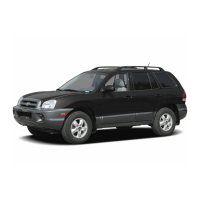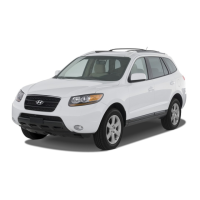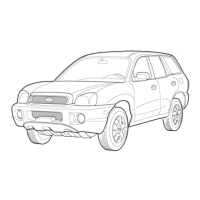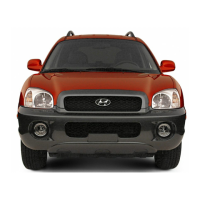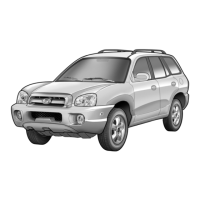Do you have a question about the Hyundai 2007 Santa Fe and is the answer not in the manual?
Details the owner's responsibility for ensuring all maintenance operations are carried out at appropriate intervals.
Provides guidance on recommended fuel types, octane ratings, and warnings about fuel additives like MTBE and methanol.
Provides safety warnings and instructions for adjusting the driver's seat and positioning for airbags.
Describes how front power seats operate and provides safety cautions for their use.
Emphasizes the importance of wearing seat belts for all occupants to reduce injury risk.
Discusses child restraint laws and proper placement of child seats in the rear seat.
Provides guidance on restraining children who are too large for child restraint systems.
Provides instructions on how to fasten the driver's seat belt correctly.
Provides guidance on proper seat belt adjustment for occupants, including warnings.
Details the requirement for child seats/infant seats and their proper installation in the rear seat.
Provides instructions on installing child restraints using tether anchor points.
Explains the procedure for installing the child restraint seat tether.
Describes how to secure child restraints using the LATCH system's lower anchors.
Provides instructions for installing a child restraint system in the rear seat center position.
Details the installation of child restraints on outboard rear seats using the automatic locking feature.
Explains the SRS system, its components, and the function of front airbags.
Lists and describes the components and functions of the SRS air bag system.
Describes the occupant classification system's role in front passenger airbag deployment.
Provides safety points for the side impact air bag system, emphasizing seat belt use and proper seating position.
Highlights safety points for curtain air bags, including child restraint installation and keeping openings unobstructed.
Provides a numbered list of all indicator lights and their meanings shown on the instrument cluster.
Describes the malfunction indicator light for exhaust gas related components and system operation.
Explains the TPMS malfunction indicator and when to have the system checked.
Explains how the low tire pressure position telltale indicates which tire is under-inflated.
Describes the low fuel level warning light and its implications for the engine.
Details the activation of the seat belt warning light and chime under various conditions.
Explains the parking brake and low brake fluid level warning lights and their operation.
Describes the charging system warning light and what it indicates about the electrical system.
Explains the low oil pressure warning light and the potential engine damage if it remains on.
Describes the SRS service reminder indicator and when it should be checked.
Explains the ABS service reminder indicator and when it indicates a malfunction.
Describes the immobilizer warning light and when it indicates a malfunction.
Describes how to read the engine coolant temperature gauge and actions to take if overheating occurs.
Explains the operation of the turn signals, headlights, and high beams via the multi-function switch.
Describes the Z-Nav™ Compass display showing vehicle heading and basic cardinal headings.
Explains how to turn the compass display ON/OFF and set operating zone numbers.
Explains how to determine and set the compass zone number based on current location.
Describes the automatic-dimming mirror with compass display and HomeLink® system for garage door activation.
Provides notes and recommendations for programming HomeLink® to garage door openers or gate operators.
Explains how to engage and release the parking brake for manual transaxle vehicles.
Describes how to engage and release the parking brake for automatic transaxle vehicles.
Provides step-by-step instructions on how to set the cruise control speed.
Explains how to use the MODE button to select Radio, CD, and CDC modes.
Explains how to control the fan speed for air flow from the ventilation system.
Describes how to select fresh outside air or recirculate inside air.
Explains how to turn the air conditioning on or off using the A/C button.
Provides instructions for using the air conditioning to cool the interior.
Explains how to set the system for dehumidified heating.
Details the automatic heating and cooling controls for setting desired temperature.
Explains how the FATC system automatically controls heating and cooling based on temperature settings.
Shows the front panels of different audio system models (D445S, D465S, D466S).
Describes the components of the audio system and its control types.
Explains the general controls used to operate the entire audio system, like power and volume.
Details controls for operating, navigating, and changing settings for the AM/FM tuner.
Explains how to operate the CD player/changer and navigate discs and playback settings.
Describes how to operate, navigate menus, and change settings for the SDAR (XM) system.
Explains how to switch between CD and RSE modes and control RSE functions.
Explains how to turn the audio system on/off and adjust speaker volume.
Explains how to switch between RSE and CD modes using the CD/RSE button.
Provides warnings about the dangers of engine exhaust fumes and precautions to take.
Details the increased risk of rollover for SUVs and the importance of safe driving practices.
Provides a checklist of pre-start checks for safe vehicle operation.
Explains the combination ignition switch and the procedure for starting the engine.
Provides instructions on how to remove the ignition key and warnings about running the engine in enclosed areas.
Explains normal conditions, the starting procedure, and the shift pattern for manual transaxle.
Describes the automatic transaxle, its selector lever positions, and notes on shifting.
Provides essential safety tips for driving a vehicle with AWD.
Provides a step-by-step guide to determine the correct load limit for the vehicle.
Provides troubleshooting steps for when the engine will not start.
Gives detailed instructions and safety precautions for jump starting a vehicle.
Outlines steps to take if the engine overheats, including safety warnings about the radiator cap.
Explains the TPMS, its indicators, and the importance of maintaining correct tire pressure.
Describes the low tire pressure telltales and actions to take when they illuminate.
Provides instructions for changing a tire, including handling TPMS sensors and warnings about tire sealants.
Provides instructions and warnings for using the temporary spare tire.
Guides the driver on actions to take if a tire goes flat while driving.
Details the procedure for changing a flat tire, including safety warnings.
Explains how to raise the vehicle using the jack and includes critical safety warnings.
Provides instructions on how to remove the flat tire and install the spare tire.
Provides recommendations for towing the vehicle safely and correctly.
Provides instructions and cautions for towing a 4-wheel drive vehicle.
Explains how to perform emergency towing when commercial services are unavailable.
Emphasizes keeping the car clean, especially the underside, to prevent corrosion.
Explains the importance of performing maintenance procedures to comply with warranties.
Describes inspection, adjustment, and replacement procedures listed in maintenance charts.
Lists emission control items with their maintenance operations and intervals.
Lists general items requiring inspection, cleaning, adjustment, repair, or replacement.
Specifies maintenance intervals for engine oil and filter under severe driving conditions.
Details maintenance intervals for the air cleaner filter under severe driving conditions.
Specifies maintenance intervals for brake pads, calipers, and rotors.
Explains the importance of changing engine oil and filter at specified intervals.
Lists the main components in the engine compartment for inspection and servicing.
Provides instructions on how to check the engine oil level after warming the engine.
Provides instructions on how to add engine oil, with cautions about hot parts and overfilling.
Recommends high-quality ethylene-glycol coolant and provides a concentration table.
Explains how to check the coolant level in the reservoir and add coolant if necessary.
Provides instructions for replacing front windshield wiper blades.
Explains how to check the automatic transaxle fluid level regularly.
Provides cautions for handling brake fluid and checking its level.
Explains how to check the brake fluid level in the reservoir.
Provides instructions for adding brake fluid, with warnings about handling and container use.
Provides steps to check the air conditioning operation and when to have it inspected.
Provides a procedure for replacing blown accessory fuses.
Provides a diagram and list of fuses and circuits protected in the engine compartment fuse box.
Explains the three emission control systems and recommends dealer inspection.
Explains the evaporative emission control system's role in preventing fuel vapor escape.
Explains the function of the catalytic converter in reducing exhaust emissions.
Provides information on tires, including their construction and grading.
Lists recommended cold tire inflation pressures for the vehicle.
Provides instructions on how to check tire inflation pressure when tires are cold.
Explains the standardized information found on tire sidewalls.
Describes when to replace tires based on tread wear indicators, wear, or damage.
Lists the items delivered with the vehicle: spare tire, wheel wrench, jack, and towing hook.
Explains the Department of Transportation quality grades for tires: Treadwear, Traction, and Temperature.
Instructs owners to report vehicle defects to NHTSA and Hyundai Motor America.
Lists tire types, sizes, and inflation pressures for normal load and maximum load.
Provides detailed specifications for the 2.7L and 3.3L gasoline engines.
Details recommended oils, fluids, and quantities for various vehicle components.
| Brand | Hyundai |
|---|---|
| Model | 2007 Santa Fe |
| Category | Automobile |
| Language | English |




